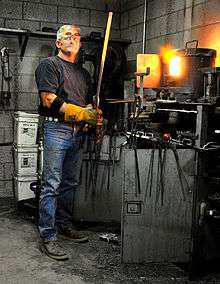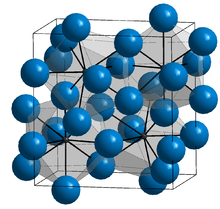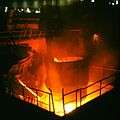Damascus steel
Damascus steel was a type of steel used for manufacturing sword blades in the Near East made with wootz steel.[1] These swords are characterized by distinctive patterns of banding and mottling reminiscent of flowing water. Such blades were reputed to be tough, resistant to shattering and capable of being honed to a sharp, resilient edge.[2]
The steel is named after Damascus, the capital city of Syria. It may either refer to swords made or sold in Damascus directly, or it may just refer to the aspect of the typical patterns, by comparison with Damask fabrics (which are in turn named after Damascus).[3][4]
The original method of producing Damascus steel is not known. Modern attempts to duplicate the metal have not been entirely successful due to differences in raw materials and manufacturing techniques. Several individuals in modern times have claimed that they have rediscovered the methods by which the original Damascus steel was produced.[5][6]
The reputation and history of Damascus steel has given rise to many legends, such as the ability to cut through a rifle barrel or to cut a hair falling across the blade.[7] A research team in Germany published a report in 2006 revealing nanowires and carbon nanotubes in a blade forged from Damascus steel.[8][9][10] Although certain types of modern steel outperform these swords, chemical reactions in the production process made the blades extraordinary for their time, as Damascus steel was superplastic and very hard at the same time. During the smelting process to obtain Wootz steel ingots, woody biomass and leaves are known to have been used as carburizing additives along with certain specific types of iron rich in microalloying elements. These ingots would then be further forged and worked into Damascus steel blades, and research now shows that carbon nanotubes can be derived from plant fibers,[11] suggesting how the nanotubes were formed in the steel. Some experts expect to discover such nanotubes in more relics as they are analyzed more closely.[9]
History

Damascus blades were manufactured in the Near East from ingots of wootz steel that were imported from India,[1] as well as Sri Lanka.[12] Archaeological evidence suggests that the crucible steel process started in the present-day Tamil Nadu before the start of Common Era. The Arabs introduced the Indian wootz steel to Damascus, where a weapons industry thrived.[13] From the 3rd century to the 17th century, India was shipping steel ingots to the Middle East.[14]
Loss of the technique
Production of these patterned swords gradually declined, ceasing by around 1750, and the process was lost to metalsmiths. Several modern theories have ventured to explain this decline, including the breakdown of trade routes to supply the needed metals, the lack of trace impurities in the metals, the possible loss of knowledge on the crafting techniques through secrecy and lack of transmission, suppression of the industry in India by the British Raj,[15] or a combination of all the above.[5][6][16]
The original Damascus steel or wootz was imported from India to Damascus, where bladesmiths learned how to forge them into swords.[5][6] Due to the distance of trade for this steel, a sufficiently lengthy disruption of the trade routes could have ended the production of Damascus steel and eventually led to the loss of the technique in India. As well, the need for key trace impurities of tungsten or vanadium within the materials needed for production of the steel may be absent if this material was acquired from different production regions or smelted from ores lacking these key trace elements.[5] The technique for controlled thermal cycling after the initial forging at a specific temperature could also have been lost, thereby preventing the final damask pattern in the steel from occurring.[5][6]
The discovery of carbon nanotubes in the Damascus steel's composition supports this hypothesis, since the precipitation of carbon nanotubes probably resulted from a specific process that may be difficult to replicate should the production technique or raw materials used be significantly altered.[16]
Reproduction

Recreating Damascus steel is a subfield of experimental archaeology. Many have attempted to discover or reverse-engineer the process by which it was made.
Moran: billet welding
Since the well-known technique of pattern welding produced surface patterns similar to those found on Damascus blades, some blacksmiths were erroneously led to believe that Damascus blades were made using this technique, but today, the difference between wootz steel and pattern welding is fully documented and well understood. Pattern-welded steel has been referred to as "Damascus steel" since 1973 when Bladesmith William F. Moran unveiled his "Damascus knives" at the Knifemakers' Guild Show.[17][18] This "Modern Damascus" is made from several types of steel and iron slices welded together to form a billet, and currently the term "damascus" (although technically incorrect) is widely accepted to describe modern pattern welded steel blades in the trade.[19] The patterns vary depending on how the smith works the billet.[18] The billet is drawn out and folded until the desired number of layers are formed.[18] In order to attain a Master Smith rating with the American Bladesmith Society that Moran founded, the smith must forge a damascus blade with a minimum of 300 layers.[20]
Verhoeven and Pendray: crucible
J. D. Verhoeven and A. H. Pendray published an article on their attempts to reproduce the elemental, structural, and visual characteristics of Damascus steel.[5] They started with a cake of steel that matched the properties of the original wootz steel from India, which also matched a number of original Damascus swords to which Verhoeven and Pendray had access. The wootz was in a soft, annealed state, with a grain structure and beads of pure iron carbide which were the result of its hypereutectoid state. Verhoeven and Pendray had already determined that the grains on the surface of the steel were grains of iron carbide—their goal was to reproduce the iron carbide patterns they saw in the Damascus blades from the grains in the wootz.
Although such material could be worked at low temperatures to produce the striated Damascene pattern of intermixed ferrite and cementite bands in a manner identical to pattern-welded Damascus steel, any heat treatment sufficient to dissolve the carbides would permanently destroy the pattern. However, Verhoeven and Pendray discovered that in samples of true Damascus steel, the Damascene pattern could be recovered by aging at a moderate temperature. They found that certain carbide forming elements, one of which was vanadium, did not disperse until the steel reached higher temperatures than those needed to dissolve the carbides. Therefore, a high heat treatment could remove the visual evidence of patterning associated with carbides but did not remove the underlying patterning of the carbide forming elements; a subsequent lower-temperature heat treatment, at a temperature at which the carbides were again stable, could recover the structure by the binding of carbon by those elements.
Anosov, Wadsworth and Sherby: bulat
In Russia, chronicles record the use of a material known as bulat steel to make highly valued weapons, including swords, knives and axes. Tsar Michael of Russia reportedly had a bulat helmet made for him in 1621. The exact origin or the manufacturing process of bulat is unknown, but it was likely imported to Russia via Persia and Turkestan, and it was similar and possibly the same as damascus steel. Pavel Petrovich Anosov made several attempts to reproduce the process in the mid-19th century. Wadsworth and Sherby also researched [6] the reproduction of Bulat steel and published their results in 1980.

Additional research
A team of researchers based at the Technical University of Dresden that used x-rays and electron microscopy to examine Damascus steel discovered the presence of cementite nanowires[21] and carbon nanotubes.[22] Peter Paufler, a member of the Dresden team, says that these nanostructures are a result of the forging process.[9][23]
Sanderson proposes that the process of forging and annealing accounts for the nano-scale structures.[23]
In gunmaking
Prior to the early 20th century, all shotgun barrels were forged by heating narrow strips of iron and steel and shaping them around a mandrel.[24][25] This process was referred to as "laminating" or "Damascus".[24][25] These types of barrels earned a reputation for weakness and were never meant to be used with modern smokeless powder, or any kind of moderately powerful explosive.[25] Because of the resemblance to Damascus steel, higher-end barrels were made by Belgian and British gun makers.[24][25] These barrels are proof marked and meant to be used with light pressure loads.[24] Current gun manufacturers make slide assemblies and small parts such as triggers and safeties for Colt M1911 pistols from powdered Swedish steel resulting in a swirling two-toned effect; these parts are often referred to as "Stainless Damascus".[26]
See also
References
- 1 2 Pacey, Arnold (1991). Technology in World Civilization: A Thousand-year History. MIT Press. p. 80. ISBN 978-0-262-66072-3.
- ↑ Figiel, Leo S. (1991). On Damascus Steel. Atlantis Arts Press. pp. 10–11. ISBN 978-0-9628711-0-8.
- ↑ Goddard, Wayne (2000). The Wonder of Knifemaking. Iola, WI: Krause Publications. pp. 137–145. ISBN 978-0-87341-798-3.
- ↑ Williams, Alan R. (2003). The knight and the blast furnace: a history of the metallurgy of armour in the Middle Ages & the early modern period Volume 12 of History of warfare. Leiden: BRILL. pp. 11–15. ISBN 978-90-04-12498-1.
- 1 2 3 4 5 6 J. D. Verhoeven, A. H. Pendray, and W. E. Dauksch; Pendray; Dauksch (1998). "The key role of impurities in ancient damascus steel blades". Journal of Metallurgy. 50 (9): 58. Bibcode:1998JOM....50i..58V. doi:10.1007/s11837-998-0419-y.
- 1 2 3 4 5 Jeffrey Wadsworth; Oleg D. Sherby (1980). "On the Bulat – Damascus Steel Revisited". Prog. Mater. Sci. 25 (1): 35–68. doi:10.1016/0079-6425(80)90014-6.
- ↑ Becker, Otto Matthew (1910). High-speed steel: the development, nature, treatment, and use of high-speed steels, together with some suggestions as to the problems involved in their use. New York: McGraw-Hill book company. pp. 10–14.
- ↑ Reibold, M.; Paufler, P.; Levin, A. A.; Kochmann, W.; Pätzke, N.; Meyer, D. C. (2006). "Materials: Carbon nanotubes in an ancient Damascus sabre". Nature. 444 (7117): 286. Bibcode:2006Natur.444..286R. doi:10.1038/444286a. PMID 17108950.
- 1 2 3 Legendary Swords' Sharpness, Strength From Nanotubes, Study Says. National Geographic (2010-10-28). Retrieved on 2011-11-13.
- ↑ Fountain, Henry (2006-11-28). "Antique Nanotubes". New York Times. Retrieved 2011-11-13.
- ↑ Goodell, B, Xie, X., Qian, Y., Daniel, G., Peterson, M., and J. Jellison (2008). "Carbon nanotubes produced from natural cellulosic materials" (PDF). Journal of Nanoscience and Nanotechnology. 8: 2472–2474. doi:10.1166/jnn.2008.235. PMID 18572666.
- ↑ Juleff, G. (1996). "An ancient wind powered iron smelting technology in Sri Lanka". Nature. 379 (6560): 60. Bibcode:1996Natur.379...60J. doi:10.1038/379060a0.
- ↑ Sharada Srinivasan; Srinivasa Ranganathan (2004). India's Legendary Wootz Steel: An Advanced Material of the Ancient World. National Institute of Advanced Studies. OCLC 82439861.
- ↑ Sinopoli, Carla M. (2003). The Political Economy of Craft Production: Crafting Empire in South India, c. 1350–1650. Cambridge University Press. p. 192. ISBN 0-521-82613-6.
- ↑ Burton, Sir Richard Francis (1884). "The Book of the Sword". Internet archive: Chatto and Windus. p. 111. ISBN 1605204366.
- 1 2 Milgrom, Lionel (15 November 2006). "Carbon nanotubes: Saladin's secret weapon". Royal Society of Chemistry.
- ↑ Lewis, Jack; Roger Combs (1992). Gun digest book of knives. DBI. pp. 58–64. ISBN 978-0-87349-129-7.
- 1 2 3 Kertzman, Joe (2007). Art of the Knife. Krause Publications. pp. 224–226. ISBN 978-0-89689-470-9.
- ↑ Loveless, Robert; Richard Barney (1995) [1977]. How to Make Knives. Knife World Publications. p. 169. ISBN 0-695-80913-X.
- ↑ "ABS Testing Rules and Guidelines for the Master Smith Rating" (PDF). Retrieved 2011-03-12.
- ↑ Kochmann, W.; Reibold, Marianne; Goldberg, Rolf; Hauffe, Wolfgang; Levin, Alexander A; Meyer, Dirk C; Stephan, Thurid; Müller, Heide; Belger, André; Paufler, Peter (2004). "Nanowires in ancient Damascus steel". Journal of Alloys and Compounds. 372: L15–L19. doi:10.1016/j.jallcom.2003.10.005. ISSN 0925-8388.
Levin, A. A.; Meyer, D. C.; Reibold, M.; Kochmann, W.; Pätzke, N.; Paufler, P. (2005). "Microstructure of a genuine Damascus sabre" (PDF). Crystal Research and Technology. 40 (9): 905–916. doi:10.1002/crat.200410456. - ↑ Reibold, M.; Paufler, P; Levin, AA; Kochmann, W; Pätzke, N; Meyer, DC (November 16, 2006). "Materials:Carbon nanotubes in an ancient Damascus sabre". Nature. 444 (7117): 286. Bibcode:2006Natur.444..286R. doi:10.1038/444286a. PMID 17108950.
- 1 2 Sanderson, K. (2006). "Sharpest cut from nanotube sword". Nature. 444: 286. doi:10.1038/news061113-11.
- 1 2 3 4 Simpson, Layne (2003). Shotguns & Shotgunning. Krause Publications. p. 256. ISBN 978-0-87349-567-7.
- 1 2 3 4 Matunas, Edward A. (2003). Do-It-Yourself Gun Repair. Woods N' Water Inc. p. 240. ISBN 978-0-9722804-2-6.
- ↑ Hopkins, Cameron (2000). "Damascus Knight .45". American Handgunner Magazine. 20 (4): 128.
Further reading
- Eric M. Taleff, Bruce L. Bramfitt, Chol K. Syn, Donald R. Lesuer, Jeffrey Wadsworth, and Oleg D. Sherby, "Processing, structure, and properties of a rolled ultrahigh-carbon steel plate exhibiting a damask pattern," Materials Characterization 46 (1), 11–18 (2001).
- J. D. Verhoeven, "A review of microsegregation induced banding phenomena in steels", Journal of Materials Engineering and Performance 9 (3), 286–296 (2000).
- Jeffrey Wadsworth and Oleg D. Sherby, "Damascus Steels", Scientific American, pp. 94 – 99, February 1985.
- J.D. Verhoeven, "The Mystery of Damascus Blades", Scientific American, pp. 74–79, January 2001
- Prabath Hewageegana "Early Iron and Steel production in Sri Lanka:A Scientific Perspective". Department of Physics, University of Kelaniya, Kelaniya
External links
- "Damascene Technique in Metal Working"
- "The Mystery of Damascus Blades"
- "Secret's out for Saracen sabres"
